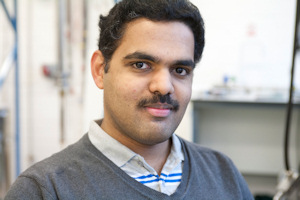Jul 3 2015
Dr Rahul Raveendran-Nair is the recipient of the 2015 Moseley medal and prize from the Institute of Physics for his outstanding contributions to our understanding of the electrical, optical and structural properties of graphene and its sister compounds.
 Dr Rahul Nair is one of the foremost graphene membrane scientists
Dr Rahul Nair is one of the foremost graphene membrane scientists
Dr Nair’s breakthrough discovery was that graphene oxide membranes, which are impermeable to helium atoms, are highly permeable to water. His pioneering work on membranes has led to significant scientific and commercial interest, with potential applications in water filtration, liquid and gas separation and anti-corrosive coatings.
Following research at the Indian Institute of Science in Bangalore on Raman spectroscopy and field emission of carbon nanotube and polymer composites, Dr Nair began his research at The University of Manchester as a PhD student, followed by appointments there as a research associate, Leverhulme Fellow and Royal Society University Research Fellow. He has recently been promoted to the position of Reader.
His research has led to several major contributions to the understanding of graphene science and its application in technology. In collaboration with University of Manchester colleagues, he also carried out high-resolution transmission electron microscopy and electron diffraction studies of freestanding graphene membranes, which elucidated the real space atomic structure of graphene.
In more recent studies, he and his colleagues have shown that the controlled incorporation of defects into graphene induces magnetic behaviour, which provides the exciting possibility of using graphene as a material for spintronic and magnetic sensing applications.
Dr Nair said: “I am delighted to have received the Moseley medal and prize. It is very satisfying as a scientist to see that my research has been recognised by the Institute of Physics.
“Graphene and related 2D materials are a fascinating area of research and I am excited about the potential for further breakthrough discoveries as we understand more and more about these novel one-atom-thick materials.”